
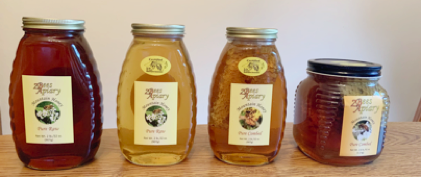
ZBees liquid gold... fresh from the colonies!

Lifetime member of the North Carolina Beekeepers Association
Apiary Population Estimating
As a beekeeper, have you ever wondered how many honeybees might exist in the typical Langstroth 10-frame hive? I was curious about the number honeybees flying around my backyard and decided to conduct some studies to determine how many bees were in each hive. Over the course of four months, I developed a method to estimate the average honey bee count per hive. If you calculate the average number of cells in a typical deep-frame you find that there are approximately sixteen workers cells per side, in a one inch square cut (see images below).
Estimating Colony Populations and Apiary Value
Estimating Colony Populations
RESEARCH 1 - Comb Measurement: Determining the potential number of cells per frame.
A Deep frame has an average comb area of 8.5” H x 17” L (actual size) or 144.5 Sq. Inches 144.5 Sq. In. x 16 cells per Sq. In. = 2,312 peak worker cells for one side OR, 2,312 x 2 = 4,624 peak worker cells per deep frame.
1. Consider an average of thirty percent (30%) empty, honey, or pollen cells, for a fully combed frame:
2. Take, 4,624 peak cells x 70% coverage = 3,237 cells per frame for brood. We can estimate 3,200 brood honeybees per frame for a good producing queen. These “average cell counts” do not account for frames in the honey supers and as such it is quite possible for a colony to reach an even higher threshold of honeybees.
RESEARCH 2 - Population Count: Actual number of honeybees on a single frame #19, at 1030 hours.
1. A hand-count revealed the average number of worker bees on this healthy and fully combed frame to be 766 workers on one side, or 1,532 estimated workers per frame.
2. Using an average of 1,500 "nurse bees," multiply this count times the average number of brood frames and the estimated count is can fall between 7,500 (5-frames) to 10,500 (7-frames) of nurse bees- not counting the bees developing in brood cells.
3. Over a period of three weeks, this number fluctuates because old foragers are dying and nursery workers are being hatched.
4. The possible number bees per healthy brood frame averages 3,200 brood cells plus 1,500 nurse bees for a per frame population of 4,700 honeybees. Multiple that times the nimber of healthy brood frames in the hive and add in the honey or pollen frame workers for per box total.
Granted, these figures are only estimates of what the average heathy hive might contain, but it gives the beekeeper a quick assessment of the value in honey bees, per hive.
Why is this important to the beekeeper?
First, let's review the average cost for a 3-pound package of honeys (average of 11,000 bees) at an average cost of $145. Second, as the hive grows in numbers so does its "live" value. Hence, a 10-frame hive box can accommodate and average of 34,200 honeybees. Now, 34,200 divided by 11,000 (package size) = 3.1 packages of honeybees per 10-frame box. At an average cost of $145 per package that means single deep hive now has an approximate bee value of $449.50 (without honey supers added). Third, as the hive grows exponentially these figures for every healthy brood box represents how a single package of honeybees can have a "future value" of approximately $899.00. Lastly, when the beekeeper loses a double brood box hive they are not losing $145 worth of bees, they are losing $899 of bees or 6.2 packages of new bees. As honey supers are added to the hive, the population increases again and so does the hive value.
EXAMPLE: In a "single brood box" colony, there are approximately 34,200 brood bees in 10-frames. Add two medium 10-frame honey supers with approximately 900 foragers per frame and you arrive at an average of 9,000 bees per super. Add 34,200 + 9,000 + 9,000 and you get and average of 52,200 bees for this 3-box hive. Divide that number by 11,000 (a 3-lb package) and it equals 4.7 packages of bees in the hive. MULTIPLY 4.7 times $145 and the bee value for this hive of bees is $681.50.
Finally, the total value of the apiary (in honeybees only) would be the total number of healthy bees in all brood boxes and honey supers, divided by 11,000, times the cost of what the beekeeper paid for a single package. As of 1 August 2022, the bee count for four hives at ZBees Apiary totals approximately 274,000. Estimated apiary bee value is 274,000 / 11,000 = 25 packages at $130.00 per package, which equates to a current estimated bee value of $3,075.00 for all honeybees on hand. Original cost for 5 packages was $650, so $3,075 - $650 equals a $2,425 growth in honeybees.
As you can ascertain, the loss of any hive has a great affect on the loss of bee dollars $$$ per hive.
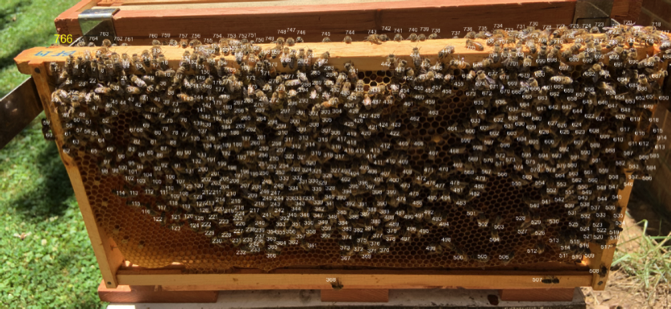
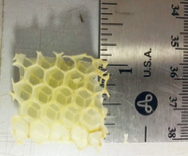
Actual number of worker cells per plastic frame is 48 rows high with 24 rows at 83 cells per row, and 24 rows at 82 cells per row. or 3,960 cells per side of a frame. Double that figure for both side of the frame and the result is 7,920 worker cells per frame.
If we calculate that thirty percent (30%) of each frame side as pollen and/or honey, then, the queen has about a seventy percent (70%) of the comb area to lay eggs. Thus, 7,920 cells times 70% means the queen could lay up to 5,554 brood eggs per frame.
Summary: 5,554 brood cells per frame times 7 brood frames = 38,808 possible new bees per box (8-frame or 10-frame). Add the additional 1,500 nurse bees per frame times the total frames and we learn that about 15,000 nurse bees are in the standard 10-frame hive body. The bee count is now close to a normal colony population of 39,046 + 15,000 for a total of 53,808 bees in a queen-right and healthy "single deep" colony.
Of course, as more brood boxes are added the colony population increases exponentially. NOW... when honey supers are added the colony can continue to increase as new workers move up to store the honey.
Medium Honey Super - has an average of 2,720 peaks cells per frame. If we calculate that bees populate about 70 percent (70%) of each frame, then, 2,720 x 0.70 = 1,904 average honey bees exists per medium frame. Multiply 1,904 x 10 = 19,040 bees per 10-frame honey super.
Estimated population of a single deep brood box 53,808 bees, plus a single honey super of 19,040 bees, equals 72,848 honey bees per colony. For every deep box of brood and medium box of honey you can add the corresponding numbers.
Multiple the average (rounded down) of bees per colony, times the number of colonies, and thus, we have the apiary bee count.
EXAMPLE 1: Using 72,000 bees as a realistic average for single-deep brood colony with one honey super and multiply this number times four (4) colonies, then the ESTIMATED apiary bee count is 288,000 total bees.
288,000 / 11,000 (bees per package) = 26 packages of bees. Multiple 26 x $145.00 ($/pkg) and the apiary now has a bee value of $3,70.00 dollars.
EXAMPLE 2: Using 72,000 bees per brood box times two (2) and the brood box count becomes 144,000 bees. Add 15,000 bees per medium honey super and you can see how the be count increases exponentially.
EXAMPLE: 6 brood frames per box times 4,700 = 28,200 brood and nurse bees. Next, add 4 honey or pollen frames with approximately 1,500 worker bees = 6,000 and the estimated number of bees per 10-frame box is 34,200 honeybees.
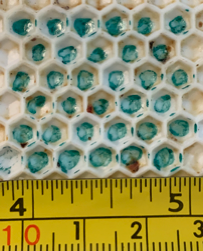
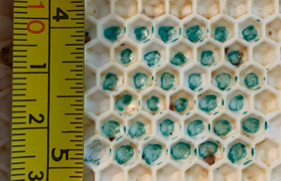
Cells per side is 36: 6 rows high x 6 columns wide OR 72 cells per sq. inch per plastic foundation.
RESEARCH 3 - Plastic or Wax Foundations: Number of cells per unit.